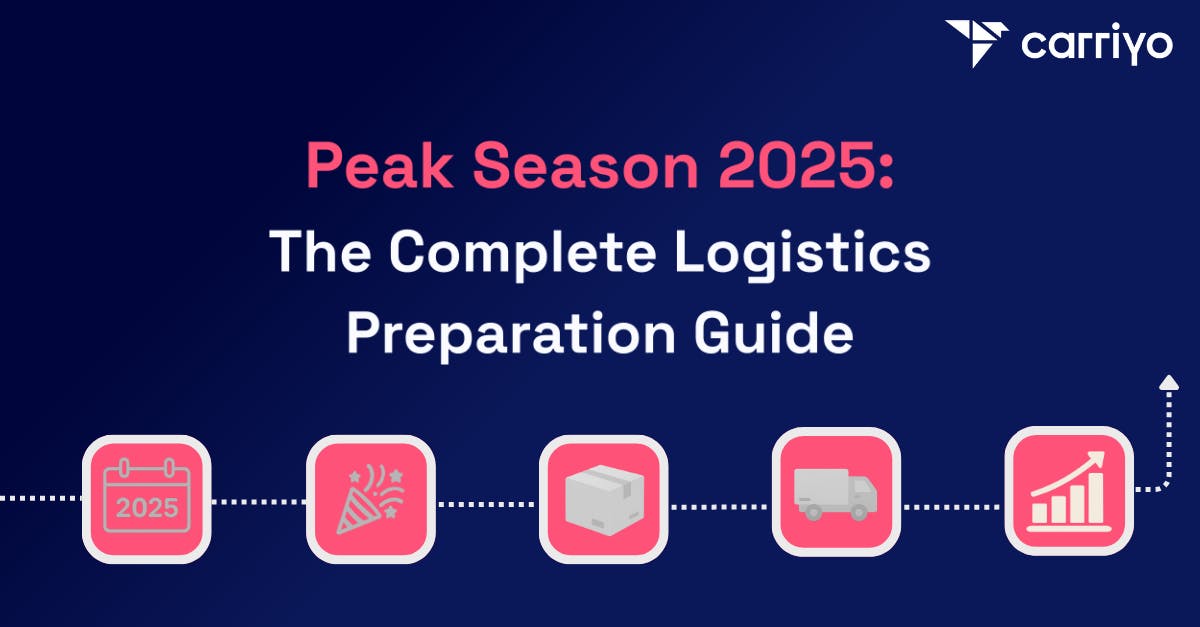
Logistics
Aug 4, 2025 - 4min read
ARTICLE
Peak Season 2025: The Complete Logistics Preparation Guide
The Pressure Is On
The second half of 2025 is about to unleash a relentless wave of peak demand events across the United States. From back-to-school rushes in August to the Black Friday-Cyber Monday marathon, from Halloween costume crazes to Christmas shipping deadlines, logistics teams are facing their most challenging months of the year.
The stakes have never been higher. In today's hyper-competitive eCommerce landscape, delays mean lost customers, stockouts spell revenue disasters, and failed deliveries can crush years of brand-building in a single peak season. Modern consumers expect same-day delivery, real-time tracking, and seamless returns—all while order volumes triple overnight.
But here's the good news: peak season success isn't left to chance. It's built through strategic preparation, smart technology adoption, and the right logistics partnerships. Let's dive into how logistics leaders can get ahead of the curve and turn peak season challenges into competitive advantages.
Key Global Peak Dates Remaining in 2025
August–September: The Warm-Up
- Back-to-School (August 15 - September 15, varies by region): Major surge in electronics, stationery, uniforms, and fashion
- Labor Day (Monday, September 1, 2025): End-of-summer retail push in the US
- Saudi National Day (Tuesday, September 23, 2025): Major promotional period in KSA with high demand for fashion, electronics, and gifts
- Start of seasonal inventory build-up: Time to position stock strategically for Q4
October: Building Momentum
- Singles Day prep (throughout October): Asia-focused brands begin aggressive inventory positioning
- Canadian Thanksgiving (Monday, October 13, 2025): Gifting surge in Canada
- Diwali Festival (October 20-24, 2025): Massive surge in gifting, apparel, and electronics across South Asia
- Halloween (Friday, October 31, 2025): Last-mile rush for costume, party supplies, and seasonal items
November: The Main Event
- Singles Day (Tuesday, November 11, 2025): China and Asia-wide shopping extravaganza
- White Friday (Friday, November 28, 2025): MENA's biggest shopping event of the year
- Black Friday (Friday, November 28, 2025): Global shopping phenomenon
- Small Business Saturday (Saturday, November 29, 2025): Supporting local businesses
- Cyber Monday (Monday, December 1, 2025): Digital-first deals and heavy cross-border volumes
December: The Final Sprint
- UAE National Day (Tuesday, December 2, 2025): Local gifting and luxury item demand spike
- Super Saturday (Saturday, December 20, 2025): Last major in-store shopping day before Christmas
- Christmas Eve (Wednesday, December 24, 2025): Final delivery cutoff for most carriers
- Christmas Day (Thursday, December 25, 2025): Final-mile delivery crunch
- Boxing Day (Friday, December 26, 2025): Major shopping event in UK, Canada, Australia
- New Year's Eve (Wednesday, December 31, 2025): Late surge for party and gift items
Pro Tip: Map demand forecasts across these dates by region, not just by campaign. Each market has its unique rhythm and customer expectations.
What Brands Need to Take Note Of
1. Delivery Speed Expectations Will Spike
The bar for delivery expectations continues to rise. Same-day and 2-day delivery have become default expectations in major markets, not premium services. Customer acquisition costs are too high to lose buyers at checkout due to slow delivery promises.
Action Items:
- Benchmark your last-mile partners' real-time performance daily, not monthly
- Set up automated alerts for delivery delays
- Consider partnering with local fulfillment networks for faster delivery times
2. Inventory Positioning Is Make-Or-Break
Gone are the days when brands could rely on centralized fulfillment. Peak season winners use forward-stocking strategies and 3PL networks to pre-position high-demand SKUs near customer hotspots.
Key Considerations:
- Watch out for warehouse cutoff dates and carrier capacity limits
- Use demand forecasting to identify which products to stock where
- Consider regional fulfillment centers for your top-selling items
3. Real-Time Visibility Isn't Optional
Modern customers expect to track their orders in real-time, and peak season multiplies this expectation. Without proper visibility, your customer service team will be overwhelmed with "Where Is My Order" (WISMO) inquiries.
Must-Haves:
- 24/7 tracking with automatic status updates
- Proactive exception handling and customer communication
- Branded tracking pages that reduce support tickets and create upsell opportunities
4. Returns Are Peaking Too
Peak season isn't just about outbound logistics—returns volume spikes dramatically post-Christmas, Singles Day, and other major shopping events. A poor returns experience can damage customer lifetime value.
Preparation Essentials:
- Ensure return policies are clear and mobile-friendly
- Set up automated return workflows
- Plan for reverse logistics capacity constraints
5. Automation Wins the Long Game
When order volumes triple overnight, manual processes become bottlenecks that can cripple your operation. Automation isn't just nice-to-have—it's essential for survival.
Automation Priorities:
- Auto-printing shipping labels and documents
- Batch shipment processing and updates
- Rule-based carrier selection and routing
- Automated customer notifications
Regional Focus: MENA Peak Season Specifics
The Middle East and North Africa region has its unique peak season dynamics that logistics teams must understand:
Critical MENA Dates:
- Back to School (August 15 - September 15, 2025): Major surge across UAE, KSA, and Egypt for uniforms, electronics, and stationery
- Saudi National Day (Tuesday, September 23, 2025): Significant promotional period with tight logistics capacity
- White Friday (Friday, November 28, 2025): MENA's biggest shopping event, often generating more volume than Black Friday globally
- UAE National Day (Tuesday, December 2, 2025): Coming right after White Friday, this adds additional strain on delivery networks
- New Year Gifting Period (December 25, 2025 - January 1, 2026): Extended gifting season in GCC markets
MENA-Specific Considerations:
- Desert and Remote Area Cutoffs: Many regional carriers have specific cutoff times for desert zones—map these carefully
- Cash on Delivery (COD) Dominance: COD still dominates in many MENA markets, requiring efficient failed delivery and returns workflows
- Mobile-First Communication: SMS and WhatsApp tracking updates often outperform email in engagement and resolution rates
Peak Season Preparation Checklist
Immediate Actions (Complete by End of August):
- Audit all carriers for peak surcharges, capacity limits, and cutoff dates
- Stress-test your systems - WMS, OMS, and shipping APIs under peak load conditions
- Pre-schedule seasonal workflows for flash sales, product drops, and promotional campaigns
- Verify branded tracking and notifications are fully operational and mobile-optimized
- Update return policies and workflows for peak season volume and customer expectations
- Align with marketing and CX teams on realistic delivery promises and customer communication
Technology and Process Optimization:
- Implement multi-carrier automation to distribute volume and reduce single points of failure
- Set up real-time monitoring dashboards for key performance indicators
- Create escalation procedures for delivery exceptions and customer issues
- Prepare your customer service team with peak season scripts and resolution procedures
- Establish backup plans for carrier outages and capacity constraints
Partnership and Capacity Planning:
- Secure guaranteed capacity with your key carrier partners
- Identify backup carriers for overflow volume and geographical coverage gaps
- Test all integrations with carriers, 3PLs, and technology partners
- Coordinate with suppliers on inventory delivery schedules to avoid warehouse bottlenecks
How Modern Logistics Platforms Help
Peak season success requires more than just good planning—it demands the right technology infrastructure. Modern logistics platforms offer several advantages:
Multi-Carrier Automation: Automatically route shipments to the best carrier based on delivery speed, cost, and reliability, while maintaining backup options for peak volume overflow.
Real-Time Tracking and Alerts: Provide customers with proactive updates while giving operations teams early warning of potential issues.
Branded Customer Communication: Reduce support tickets while creating additional touchpoints for customer engagement and upselling.
Streamlined Returns Management: Automated return workflows that handle the post-peak returns surge efficiently.
Performance Analytics: Real-time insights into carrier performance, delivery success rates, and customer satisfaction metrics.
The Bottom Line: Peak Success Starts Now
Peak season isn't won during peak season—it's won in the months of preparation beforehand. The brands that will thrive during the intense shopping periods ahead are those that start preparing now, not when the orders start flooding in.
Every day of preparation can save weeks of crisis management. Every automated workflow implemented now can handle thousands of peak season orders without human intervention. Every carrier relationship strengthened today can provide crucial capacity when you need it most.
The question isn't whether peak season will be challenging—it will be. The question is whether your logistics operation will be ready to turn that challenge into your competitive advantage.
How Carriyo Powers Peak Season Success
Peak season demands more than just good planning—it requires a logistics platform built for scale, speed, and reliability. Carriyo helps ecommerce brands turn peak season challenges into competitive advantages:
Multi-Carrier Automation: Automatically distribute shipments across 100+ carriers including USPS, UPS, FedEx, and regional partners. When one carrier hits capacity limits, your orders seamlessly route to available alternatives without manual intervention.
Real-Time Tracking & Proactive Alerts: Keep customers informed with branded tracking pages and automatic notifications via SMS, email, and push notifications. Reduce WISMO inquiries by up to 80% while creating additional touchpoints for customer engagement.
Intelligent Shipping Rules: Set up automated rules that optimize for cost, speed, or reliability based on your peak season priorities. Route high-value orders to premium carriers while sending standard orders through the most cost-effective options.
Peak Season Analytics: Monitor carrier performance, delivery success rates, and customer satisfaction in real-time. Identify bottlenecks before they impact your business and make data-driven decisions during the chaos of peak season.
Streamlined Returns Management: Handle the post-peak returns surge with automated return workflows, branded return portals, and reverse logistics optimization. Turn returns from a cost center into a customer retention opportunity.
Enterprise Scalability: Process thousands of shipments per hour with sub-second API response times. Our cloud-native architecture scales automatically during peak volume spikes without performance degradation.
From automating your busiest shipping days to providing the visibility you need to stay ahead of issues, Carriyo ensures your peak season runs smoothly while your team focuses on growing the business.
Ready to make peak season your most profitable season? Carriyo's all-in-one logistics platform handles the complexity so you can focus on what matters most—delivering exceptional customer experiences that drive repeat business.
Contact Carriyo Sales Representative | Book a Meeting with Carriyo
Peak season preparation requires the right strategy, technology, and partnerships. Don't leave your biggest revenue opportunity of the year to chance—start building your peak season advantage today.
01

Joao Vieira
CRO at CARRIYO
Inside the City: How Urban Freight and Micro-Distribution Are Redefining the Last Mile
Oct 7, 2025 - 4min read
02

Faisel Azeez
Co-Founder & CTO
Connected Fleets: How Telematics and Data Are Powering the Next Generation of Logistics
Oct 6, 2025 - 5min read
03

Joao Vieira
CRO at CARRIYO
Last Mile, First Priority: Why Experience Matters More Than Speed
Oct 2, 2025 - 5min read
Automate shipping operations and elevate post-purchase customer experience
We're trusted by

